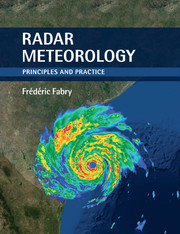Book contents
- Frontmatter
- Dedication
- Contents
- Preface
- Notation
- 1 Meteorology and radar
- 2 Fundamentals of weather radar measurements
- 3 Radar reflectivity and products
- 4 Reflectivity patterns
- 5 Doppler velocity information
- 6 The added value of dual polarization
- 7 Convective storm surveillance
- 8 Monitoring widespread systems
- 9 Radar estimation of precipitation
- 10 Nowcasting
- 11 Additional radar measurements and retrievals
- 12 Cloud and spaceborne radars
- 13 What does radar really measure?
- Appendix A Mathematics and statistics of radar meteorology
- References
- Index
12 - Cloud and spaceborne radars
Published online by Cambridge University Press: 05 June 2015
- Frontmatter
- Dedication
- Contents
- Preface
- Notation
- 1 Meteorology and radar
- 2 Fundamentals of weather radar measurements
- 3 Radar reflectivity and products
- 4 Reflectivity patterns
- 5 Doppler velocity information
- 6 The added value of dual polarization
- 7 Convective storm surveillance
- 8 Monitoring widespread systems
- 9 Radar estimation of precipitation
- 10 Nowcasting
- 11 Additional radar measurements and retrievals
- 12 Cloud and spaceborne radars
- 13 What does radar really measure?
- Appendix A Mathematics and statistics of radar meteorology
- References
- Index
Summary
There is a new role for radar since the eve of the twenty-first century. It arose from the growing interest in clouds and global precipitation, partly fueled by the wish to better understand the Earth energy balance and hydrological cycle, and partly in response for the need to improve the simulation of clouds and of precipitation in climate models. Both of these needs require shorter wavelength radars: ground-based cloud studies are best made with radars that have narrower beam widths and greater sensitivity to cloud droplets and ice crystals, while global cloud and precipitation monitoring requires radars that are both small enough to be carried on satellites, yet have sufficient resolution and sensitivity to make useful measurements. These radars also tend to be used differently than weather radars, the focus being more on cloud and precipitation microphysics and the characterization of long-term statistics rather than on storm processes and minute-to-minute weather surveillance and nowcasting. These differences in focus have led to the emergence of two distinct communities of radar meteorologists who largely work in isolation of one another. The use of shorter wavelengths either from a ground-based or a spaceborne platform gives rise to a combination of challenges and opportunities that are unique to these radars and deserve a special discussion in this chapter.
Cloud radars
12.1.1 Radars for cloud studies
The contribution of clouds on the Earth energy balance, and how it may change as a result of man-made perturbations such as greenhouse gas and aerosol emissions, remains one of the greatest sources of uncertainties in climate simulations and predictions. There is hence a societal need to better characterize clouds. In parallel, process studies of the formation of clouds and how precipitation initiates remain an active research area. Both of these research interests called for the use of new data.
But the measurements required are particularly difficult to make.
- Type
- Chapter
- Information
- Radar MeteorologyPrinciples and Practice, pp. 189 - 200Publisher: Cambridge University PressPrint publication year: 2015



